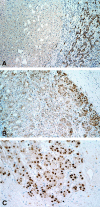Beta-catenin mutations are frequent in human hepatocellular carcinomas associated with hepatitis C virus infection
- PMID: 10595907
- PMCID: PMC1866943
- DOI: 10.1016/s0002-9440(10)65496-x
Beta-catenin mutations are frequent in human hepatocellular carcinomas associated with hepatitis C virus infection
Abstract
Hepatocellular carcinoma (HCC) is one of the most common fatal cancers worldwide. Hepatitis B virus and hepatitis C virus infections, exposure to aflatoxin, and excessive intake of alcohol have been identified as major risk factors. However, the molecular mechanisms underlying their development are still poorly understood. Recently, beta-catenin, one of the key components of the Wnt signaling pathway, has been found to be mutated in about 20% of HCCs, suggesting a role of the Wnt pathway in their development. In this study, we examined beta-catenin and APC mutations in 22 HCCs associated with HCV infection, using single-strand conformation polymorphism (SSCP) followed by direct DNA sequencing. beta-Catenin mutations were found in nine (41%) cases, but no APC mutations were found. beta-Catenin immunohistochemistry revealed nuclear accumulation of beta-catenin protein in all nine tumors with a beta-catenin mutation and two additional tumors without a mutation. These results suggest that activation of the Wnt signaling pathway by beta-catenin mutation contributes significantly to the hepatocellular carcinogenesis associated with HCV infection.
Figures


Similar articles
-
AXIN1 mutations in hepatocellular carcinomas, and growth suppression in cancer cells by virus-mediated transfer of AXIN1.Nat Genet. 2000 Mar;24(3):245-50. doi: 10.1038/73448. Nat Genet. 2000. PMID: 10700176
-
Beta-catenin mutations are associated with a subset of low-stage hepatocellular carcinoma negative for hepatitis B virus and with favorable prognosis.Am J Pathol. 2000 Sep;157(3):763-70. doi: 10.1016/s0002-9440(10)64590-7. Am J Pathol. 2000. PMID: 10980116 Free PMC article.
-
Alterations of RB1, p53 and Wnt pathways in hepatocellular carcinomas associated with hepatitis C, hepatitis B and alcoholic liver cirrhosis.Int J Cancer. 2003 Sep 1;106(3):334-41. doi: 10.1002/ijc.11254. Int J Cancer. 2003. PMID: 12845670
-
Alterations of Wnt/β-catenin signaling pathway in hepatocellular carcinomas associated with hepatitis C virus.Pol J Pathol. 2015 Mar;66(1):9-21. doi: 10.5114/pjp.2015.51148. Pol J Pathol. 2015. PMID: 26017875 Review.
-
[beta-catenin].Nihon Rinsho. 2001 Oct;59 Suppl 6:161-6. Nihon Rinsho. 2001. PMID: 11761935 Review. Japanese. No abstract available.
Cited by
-
Pathway Analyses Identify Novel Variants in the WNT Signaling Pathway Associated with Tuberculosis in Chinese Population.Sci Rep. 2016 Jun 23;6:28530. doi: 10.1038/srep28530. Sci Rep. 2016. PMID: 27334567 Free PMC article.
-
B cells in chronically hepatitis C virus-infected individuals lack a virus-induced mutation signature in the TP53, CTNNB1, and BCL6 genes.J Virol. 2013 Mar;87(5):2956-62. doi: 10.1128/JVI.03081-12. Epub 2012 Dec 26. J Virol. 2013. PMID: 23269799 Free PMC article.
-
Oncogenic Signaling Induced by HCV Infection.Viruses. 2018 Oct 2;10(10):538. doi: 10.3390/v10100538. Viruses. 2018. PMID: 30279347 Free PMC article. Review.
-
Wnt Signaling in vascular eye diseases.Prog Retin Eye Res. 2019 May;70:110-133. doi: 10.1016/j.preteyeres.2018.11.008. Epub 2018 Dec 1. Prog Retin Eye Res. 2019. PMID: 30513356 Free PMC article. Review.
-
Humanized Mouse Models for the Study of Hepatitis C and Host Interactions.Cells. 2019 Jun 17;8(6):604. doi: 10.3390/cells8060604. Cells. 2019. PMID: 31213010 Free PMC article. Review.
References
-
- Barth AI, Nathke IS, Nelson WJ: Cadherins, catenins, and APC protein: interplay between cytoskeletal complexes and signaling pathways. Curr Opin Cell Biol 1997, 9:683-690 - PubMed
-
- Behrens J, von Kries JP, Kuhl M, Bruhn L, Wedlich D, Grosschedl R, Birchmeier W: Functional interaction of β-catenin with the transcription factor LEF-1. Nature 1996, 382:638-642 - PubMed
-
- Rubinfeld B, Albert I, Porfiri E, Fiol C, Munemitsu S, Polakis P: Binding of GSK3b to the APC-β-catenin complex and regulation of complex assembly. Science 1996, 272:1023-1026 - PubMed
Publication types
MeSH terms
Substances
LinkOut - more resources
Full Text Sources
Other Literature Sources
Medical
Miscellaneous

